The costs of inclusion: Incorporating existing bus operators into Mexico City’s emerging bus rapid transit system
Implementing bus rapid transit (BRT) in systems characterized by a strong presence of weakly regulated private bus operators can be categorized along a “force-foster” continuum, representing the range in effort to replace incumbents. We examine the fostering end of the spectrum in terms of the consequences of incorporating, rather than replacing, existing operators. While the immediate effect enhances the political feasibility of implementation, what are the longer-term consequences on project sustainability? We hypothesize that the short-term political gain from involving existing bus operators may a) negatively affect performance, b) reduce leverage to regulate the emerging system, c) increase operating costs, and/or d) constrain the ability to expand or integrate the system in the future. We test our hypothesis by examining four BRT corridors implemented in Mexico City between 2005 and 2012. Our findings confirm BRT’s potential to transition away from weakly regulated, privatized and atomized systems and empower the state as planner and regulator. We also find longer-term challenges, particularly in the form of non-explicit subsidies to the system and related expectations for subsequent negotiations. The cases suggest that, when managed without a healthy dose of conflict, compromises can be costly. Cities pursuing a “fostering” approach to public transport industry transition should take note.
BRT is the way forward
Source: Opinion on O Globo by Luis Antonio Lindau, president of EMBARQ Brazil and member of our Centre. Published on September, 7th, 2012.
 One of Brazil’s biggest challenges is to implement extensive and high quality public transportation networks in large cities.
One of Brazil’s biggest challenges is to implement extensive and high quality public transportation networks in large cities.
We gave away the urban road space to cars. Today we seek for solutions to one of the worst impacts of this wrong decision: traffic jams. Many of us believe that only metro systems can save mobility, as metros already proved to be effective in cities that developed extensive networks formed by several lines.
London and New York metro networks are longer than 350 km, and were consolidated half a century ago. Beijing and Shanghai are getting there: in the last 12 years, jumped from scarce 50 to over 350 km, as result of huge state investments. In Brazil, in spite of 30 years of metro construction, Rio de Janeiro and Sao Paulo still lack a comprehensive network, having not yet achieved 50 and 100 km, respectively.
Metros are very costly and require long periods for implementation. Isolated lines will not solve the transportation problem of our several large cities. If we continue to believe that the only solution to traffic congestion relies on a system that in Brazil expands at an average rate of 3 km per year, we are doomed to a future even more chaotic.
In the current world scenario, dictated by public-private partnerships, it is hard to imagine the construction of large metro networks in any Brazilian city. The private sector is interested in projects with positive financial returns. Its metro participation is thus narrowed to lines with heavy demand potential.
We know that investing only in public transportation is not enough to solve traffic congestion. To discourage car use, we must count on an integrated transit network of high quality. That is why more than a hundred cities around the world reordered the use of the road surface, dedicating a 3.5 m wide lane to public transport, which carries up to ten times more people than cars. Several of them also added to that connectivity, speed and reliability, some of the transit users´ most desired attributes.
A proper public transportation network needs to connect multiple sectors of a city over long periods of time. Its vehicles must circulate free of traffic congestion, operate under short intervals and guarantee arrivals on time. The “metronization” of the buses, a concept originally applied by former mayor Jaime Lerner in Curitiba, today matches stopping, accelerated and express services, making BRT (Bus Rapid Transit) the most efficient user of the urban road surface.
Rio de Janeiro is consolidating its integrated transportation network with BRT corridors that will exceed 150 km by 2016. The recently inaugurated Transoeste corridor has been approved by 90% of its users. This very positive rating follows the trend of other BRT, like Metrobus in Mexico City. In a city wide poll promoted by Reforma newspaper in 2011, BRT beat even the metro as the best transit system: 7.8 to 6.9.
The attack to urban road congestion must begin with setting up a fully integrated and high quality transit network that appeals most citizens. That is the premise to contain the unrestricted use of cars. But when will we get there? To implement high quality public transportation networks, consistent with our financial reality, how about forgetting the sterile discussion on metro versus BRT and start acting?
¿Comments? ¿Opinions? ¿Similar News? Send them to us!
Tweet
Do Bus Rapid Transit right, and it won’t get killed
Source: Next American City
 In Delhi, India, a poorly planned system causes congestion and delays for bus, car and pedestrian traffic. The problem: It’s not true BRT. Credit: ITDP
In Delhi, India, a poorly planned system causes congestion and delays for bus, car and pedestrian traffic. The problem: It’s not true BRT. Credit: ITDP
The growth in popularity of bus rapid transit (BRT) in the U.S. is providing American cities with an important public transit option that has already been shown to reduce congestion and improve quality of life for urban residents around the world. As new BRT systems are planned, however, it is increasingly important that they meet the emerging industry-standard definition of what constitutes true BRT.
Such a standard will guard against the missteps described in this post by Dan Malouff, which detailed two failed attempts at quasi-BRT systems in the U.S. and India.
Earlier this year, the Institute for Transportation and Development Policy, together with many of the world’s leading BRT experts, introduced The BRT Standard: Version 1.0, currently in its pilot year and set for wide distribution in 2013. As the metrics of this scoring system demonstrate, the two examples Malouff cites are very clearly not best practices — nor are they even BRT.
The bus system in Delhi, India, for example, scores a 22 (out of 100) and falls well below what is required for a system to be considered BRT. Stations, placed at intersections, leave insufficient space for free left turns (the equivalent of free right turns in the U.S.), and left-turning vehicles yielding to pedestrians back up traffic. In addition, failing to eliminate turns across the busway significantly slows both bus and car traffic, and fares are collected onboard the bus, which slows boarding times. There is no off-board fare collection, a key aspect of BRT. The system also allows non-BRT buses into the bus lane, so there is no consistency in at-level boarding — which doesn’t require passengers to step up to board and is a critical element to a smooth BRT experience.
All of these issues reduce overall bus speeds on the corridor, thereby reducing passenger comfort. Finally, stations are not of a particularly high quality and are generally poorly maintained. No wonder the city’s high court is considering opening these bus lanes up to car traffic.
Virginia’s Shirley Highway Busway, while once a well-functioning bus lane on a highway, lacked many of the quality-of-service features necessary to make it a world-class BRT system. There were no permanent stations and no off-board fare collection. As its conduit was a highway lane, it was never integrated with bicycling and walking infrastructure. In addition, the frequency of buses was too low, leading to the none-too-rare sight of an empty lane flanking a congested highway. The state has since reduced restrictions on cars allowed in the bus lane, and will soon even permit single-occupant vehicles to use it.
The reality is that dismantling a BRT system only happens when the quality of the system is already too low for it to be viewed as a permanent part of the city’s infrastructure. Cleveland’s HealthLine BRT corridor, which features high-quality stations, off-board fare collection, median-aligned dedicated bus lanes and at-level boarding, is a leading example in the U.S. of a world-class BRT project. The HealthLine joins the ranks of other internationally recognized leaders such as Ahmedabad’s Janmarg in India, Johannesburg’s Rea Vaya in South Africa and the Guangzhou BRT in China.
Such systems have never been, nor are they likely to be, dismantled with the stroke of a pen. They continue to be trusted to maintain their exclusive lanes, and to remain a permanent part of the urban form in their respective home cities.
¿Comments? ¿Opinions? ¿Similar News? Send them to us!
Tweet
Course: Innovation in the design and operation of urban public transport systems
 The Transport Innovation Centre (CENIT) of the Universidad Politécnica de Cataluña (Barcelona, Spain) invited our Director, Juan Carlos Muñoz, to give this 10 teaching hours course on September 3-4, 2012. The group of 45 participants included authorities, operators, professors, researchers and students involved in the public transport area.
The Transport Innovation Centre (CENIT) of the Universidad Politécnica de Cataluña (Barcelona, Spain) invited our Director, Juan Carlos Muñoz, to give this 10 teaching hours course on September 3-4, 2012. The group of 45 participants included authorities, operators, professors, researchers and students involved in the public transport area.
The focus of the course, which was given in Spanish, was to explain some of the main research findings of our Centre of Excellence. The state of practice of BRT implementations around the world was described, and a critic analysis of their planning was presented, with special focus on the case of Transantiago (Santiago, Chile).
More information in the following documents (in Spanish):
Course brochure
Introduction to the BRT Centre of Excellence
BRT Corridors Around the World
Operation and Fare Integration
Key Attributes for Route and Mode Election
Design of Express Services
Real Time Control in Buses
¿Comments? ¿Opinions? ¿Similar News? Send them to us!
Tweet
Evaluate, Enable, Engage: Principles to Support Effective Decision Making in Mass Transit Investment Programs
Source: EMBARQ
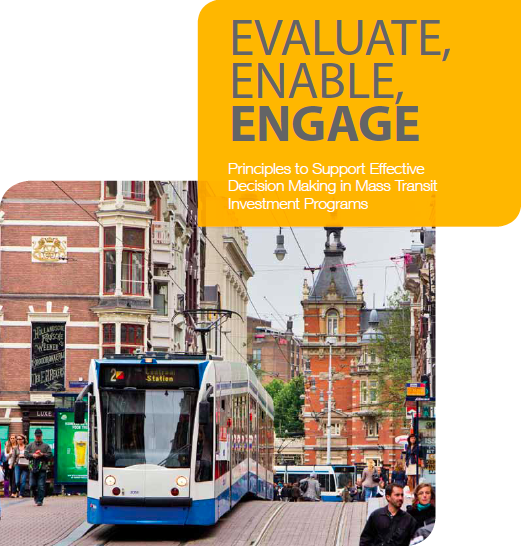 Between 2000 and 2030, developing countries are expected to build more urban area than has been built throughout human history. Urban populations in China and India will grow by at least 600 million residents by 2030, roughly twice the current population of the entire United States. Without major mobility investments, many rapidly growing cities will face traffic and economic gridlock.
Between 2000 and 2030, developing countries are expected to build more urban area than has been built throughout human history. Urban populations in China and India will grow by at least 600 million residents by 2030, roughly twice the current population of the entire United States. Without major mobility investments, many rapidly growing cities will face traffic and economic gridlock.
Against a backdrop of increasing urban mobility demands and growing concerns about the impacts of climate change, more national governments are investing in the development of urban and metropolitan mass transit systems. Within the last 10 years, national governments in several populous countries with quickly growing economies, including India, Mexico, and Brazil, have introduced programs to fund at least a portion of the construction costs of new mass transit systems. They join countries with more mature transport infrastructure, including France, the United Kingdom and the United States, that have continued and, in some cases, increased their investments in mass transit.
This report from EMBARQ examines 13 existing national mass transit investment programs from the perspective of informed decision making. Based on the reviewed national programs, the report identifies three principles to foster effective decision making in national mass transit investment:
- Rationale
- Deliverability
- Local buy-in
The insights will be of use to administrators of national mass transit investment programs that are identifying areas for improvement, national governments that are introducing new programs, and representatives of multilateral institutions that are helping to structure such programs.
Download full report here English (PDF, 70 pages, 4.32 MB)
¿Comments? ¿Opinions? ¿Similar News? Send them to us!
Tweet
Next Stop, Supreme Court, for Delhi’s Bitter Bus Corridor Battle
Source: The New York Times
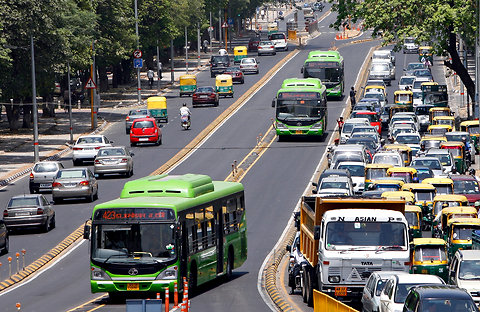 Photo: Prakash Singh/Agence France-Presse — Getty Images
Photo: Prakash Singh/Agence France-Presse — Getty Images
Delhi’s experiment with efficient public road transportation, in the form of the Bus Rapid Transit corridor, has devolved into a court battle that pitches the city’s wealthy, car-owning minority against the majority of road users.
The next step may be the highest court in the land. The Delhi government plans to appeal to India’s Supreme Court to keep the corridor car-free if Delhi’s high court, which is hearing the case now, decides that cars should be allowed in the bus-only lanes, an official in Delhi’s Transport Department told India Ink on Monday.
Delhi’s buses are residents’ most important method of transportation in the city of over 16 million. Fewer than 20 percent of road users in Delhi travel in private vehicles, including cars and scooters, while about half of all road users in Delhi commute by bus, according to the RITES Delhi Traffic and Forecast Study. The rest use bicycles or three-wheeled auto-rickshaws, or go by foot.
The BRT corridor, which is modeled after other systems in high-traffic cities like Bogota, was designed to make bus and bicycle travel safer and faster, and encourage travel that does not involve cars. It features a bicycle-only lane and a center lane just for buses.
Whether the corridor, which was completed in April 2008, has been a success depends on which camp you ask. It has saved lives, but it has also increased the travel time for car drivers. Whether it has shortened bus travel times depends on which research you read.
Drivers and their advocates are so upset that they have filed a flurry of court petitions, demanding that the corridor be shut. News coverage in some English-language newspapers, particularly The Times of India, has often been sympathetic to these drivers, calling the corridor a “nightmare” and “a volcano waiting to erupt.”
An interim court order last week directed the government to allow private vehicles to use the corridor reserved for buses. A final judgment on whether to overturn it altogether is due this month from the Delhi High Court.
According to B.B. Sharan, a retired colonel who is one of the petitioners who wants the corridor open to all vehicles, “only 50 buses plied on the corridor in an hour while the number of other vehicles was 40 to 50 times the number of buses.”
Traffic jams are a common sight on the carriageway next to the bus lane, he said. “It is unfair to give so little space to car users. Not a single car user has started using the bus; nobody has benefited from this,” he added.
Not everybody agrees with his claim.
“The number of fatal accidents reduced from an average of 9 to 10 accidents per year between 2001 and 2006 to 2 in 2009 on the stretch,” said Geetam Tiwari, Professor for Transport Planning at the Indian Institute of Technology, Delhi.
Ms. Tiwari was one of the authors of the report “Delhi on the Move: 2005,” which proposed the BRT concept and was presented to the Transport Department in 1995.
“Fatal accidents involving bicyclists have not occurred in the bicycle lane since 2008,” she added.
Dunu Roy, director of Hazards Centre in New Delhi, a nongovernmental organization, agreed with this assessment. “After the BRT became operational, not only have fatalities gone down dramatically, accidents have gone down too,” he said.
Private vehicle use is rising fast in New Delhi and most Indian metropolises: An average of 1317 vehicles, including auto-rickshaws and scooters, were added to Delhi roads every day during the 2010-11 fiscal year according to Delhi Statistical Handbook 2011, of these 95 percent were private cars and two wheelers.
Soon, Delhi’s roads won’t be able to handle the traffic, transportation experts say, making introduction of systems like the BRT necessary. “The capacity of roads in Delhi will be exceeded by 2021 on most major roads and junctions,” said Ms. Tiwari.
Convincing private vehicle owners to use public transportation remains a difficult task in India. Car-pooling web sites have sprung up recently, but bus transportation is widely seen as inconvenient, crowded and unsafe for women.
Advocates of the Bus Rapid Transit corridor argue that the interim court decision negates the corridor’s original purpose. “Allowing other vehicles in the corridor essentially destroys the corridor. There is space for everyone, but the concern of minority car users seems to influence the city engineers and traffic managers,” Ms. Tiwari said.
Even research related to the BRT is controversial. Mr. Roy of the Hazards Centre said there are multiple problems with an interim report by the Central Road Research Institute (CRRI), a national research organization, which is the basis of the interim high court order.
The CRRI had conducted a trial run between May 12 and May 23 allowing private vehicles in the bus corridor. In its report the institute concluded that traffic moved faster when other vehicles were allowed in the corridor than when they were barred, but the report did not make note of accidents or fatalities.
“Their report is completely unscientific,” Mr. Roy said. He pointed out that in the Terms of Reference the government asked for comparisons with the BRT corridor and mixed vehicle corridors on other roads. Instead, Mr. Roy said, “the CRRI modified the BRT corridor itself and compared the results.”
Subhamay Gangopadhyay, director of the institute declined to comment on the findings of the interim report and said that he would only speak once the final report is submitted to the Delhi High Court on July 12.
Zubeda Begum, the lawyer representing the Delhi government’s transport department, said that she had not looked at the CRRI interim findings but said that the organization was not an expert on the matter.
Despite the pending legal dispute, the Press Trust of India quoted Sheila Dikshit, Delhi’s chief minister, last month as saying that her government “will commission more BRT routes in the city as a means to promote public transport, as a bulk of passengers were ‘happy’ with the existing facility,” but provided no further details.
¿Comments? ¿Opinions? ¿Similar News? Send them to us!
Tweet
BRTdata.org Updates
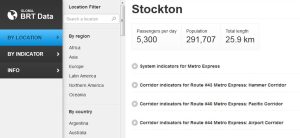 Source: EMBARQ
Source: EMBARQ
BRTdata.org, which features more than 90 geographic, statistical and service-level indicators, has been releasing updates, adding information on new lines from Mexico City to Rio de Janeiro.
The website features the most comprehensive, public database of bus rapid transit (BRT) systems around the world, launched on April 2 by our Centre of Excellence and EMBARQ, in collaboration with the International Energy Agency.
The last updates includes data now includes 143 cities’ BRT systems, representing more than 23 million daily riders. Some key updates added in this update include the Database’s newest cities, Winnipeg, Canada; Jaboatão dos Guararapes, Brazil; Stockton, the United States; Miyagi, Japan in addition to corridor updates in several South American cities in Brazil and Colombia, Australia and Japan.
The changes are listed in the Changelog of the website. Here are the highlights:
New corridors
- Jaboatão dos Guararapes, Brazil
- Stockton, the United States
- Miyagi, Japan
- Winnipeg, Canada
Modifications to existing systems/corridors
- Bogotá: city population, metropolitan population
- Guadalajara: station boarding level
- Lima: station boarding level
- Mexico City, corridors línea 1 and línea 4: # trunk routes
- Pereira: station boarding level
- Rio de Janeiro, all corridors: daily demand, peak load, # stations and station spacing
- Santiago: station boarding level
- Sydney, all corridors: system length
- Uberlândia: capital cost, infrastructure cost and equipment cost
- Vancouver: # trunk routes
- All Latin American systems: year system commenced
- Porto Alegre, all corridors: daily demand and peak load
- Santiago, all corridors: daily demand, peak load and frequency
- Santiago, corridors Parajitos Norte and Pajaritos Sur: corridor length, length of segregated lanes, # stations, and station spacing
- Santiago, corridors Suiza-Las Rejas and Santa Rosa Norte: length of segregated lanes
“This database helps researchers, transportation agencies, municipal authorities and NGOs to understand and make decisions to improve systems and BRT bus lanes in their cities” says Dario Hidalgo, director of research and practice for EMBARQ and member of our CoE.
BRTdata.org will continue to publish new or updated data on the second Thursday of each month.
¿Comments? ¿Opinions? ¿Similar News? Send them to us!
Tweet
Public transport pre-pay tickets: Understanding passenger choice for different products
Growing cashless services in the Sydney metropolitan region are motivated by the clear supply-side benefits associated with the prepayment of public transport fares. This paper examines the effect on prepay following the ‘MyZone’ fare and ticket reform in New South Wales introduced in April 2010. ‘MyZone’, introduced two new discounted and standardised prepay products, including a new, multimode ticket. Whilst these changes had implications for all public transport providers in the Sydney Metropolitan area, it had significant ramifications for the many private bus operators who, for the first time, could provide and accept tickets, which integrated their services with the state-run rail, ferry and bus network.
With empirical data collected from two surveys of passengers of a private bus operator in northern Sydney this study analyses the ticket purchasing behaviour of passengers both before the fare reform, when passengers only had access to operator-specific prepay products, and post-MyZone, when the new standardised prepay products were available. The results clearly show there are significant differences in the characteristics of passengers using multi-modal versus pay-as-you-go tickets and that this difference is driven largely by age, income and whether or not the journey involved interchange. Prior to MyZone, prepay users were easily predicted and the fare and ticket reform was successful in transitioning some cash users to prepay but prepay users were no longer predictable unless separated into prepay product groups. This suggests that a policy designed to exploit the supply-side benefits associated with cashless services needs to consider that introducing only one prepay product will not address the market need of frequent users. Passengers who continued to pay cash after the fare and ticket reform showed high sensitivity to public transport cost and are those passengers with the lowest incomes. This raises policy questions of how to mitigate against the upfront costs often associated with prepay to transition less affluent, but frequent passengers, onto cashless ticketing.
Opinion Pieces: The simple logic of getting people out of their cars and onto public transport
Opinion Pieces: since 2007, Prof. David Hensher has written an opinion column in the Australasian Bus and Coach magazine, where he monthly discusses a lot of different transport-related hot topics. In this section we are revisiting these columns.
September 2011
This opinion piece may well turn out to be the most ‘influential’ piece I have written since we started the monthly series in October 2007. The careful selection of words is quite a craft and one that begs indulgence to have maximum impact. During the Emerging Crises Summit on Cities, Population, Climate Change and Energy titled Moving People Solutions for a Growing Australia in Parliament House, Canberra (July 6 2011), I was on a panel gazetted for Road Pricing Reform. The Chair decided that Road Pricing is a long way off in terms of political agendas (despite all the lip service), and that we should focus our panel discussion on themes where we believe governments might be interested, and where they could make a difference in public transport reform.
I (and Bob Carr, former Premier of NSW) was asked to identify one very specific initiative that government’s could support (especially Federal Government) that could make a real difference to improving the performance of metropolitan transport systems.
My response, almost as if it had been brewing for many years, was to “flood the market with buses”. I connected this response to my earlier question (Opinion piece June 2011) – How many buses could the NW rail project in Sydney buy? Allowing for extra drivers, which has significant employment benefits, the current 4,000 buses operating in the Sydney metropolitan area, could be increased to at least 12,000, a three-fold increase in service capacity.
In anticipation of a loud yell of disapproval, I anticipated what the response would be. Specifically, people have told me that this would create a crisis on the roads with horrendous traffic congestion consequent on buses mixing with cars and trucks. My response is simple and accurate – if the real drivers of getting people out of their cars and into public transport are connectivity (the door-to-door element of travel, including integrated seamless multi-modal ticketing), frequency, regularity and visibility, which most would agree are the key factors, then a 300 percent increase in the service capacity of buses spread throughout the metropolitan area (or at least in areas where we believe public transport can make a difference), must surely result is some noticeable modal switching from the car, with a consequent positive impact on traffic congestion.
Given the substantial three-fold increase in service capacity, if this fails to make a dent on car use and hence traffic congestion, then what hope is there for any public transport initiative (be it new infrastructure and or new service levels) to contribute to reducing traffic congestion? Surely the failure of this initiative would send a signal about the disconnect between building the NWRail project (as one example of spending a lot of money on one narrowly focused project given the needs of entire metropolitan areas) and what it will do as a narrow corridor-specific initiative in impacting on traffic congestion (which I personally believe it will have very little impact).
I suspect that many politicians would agree with me, but so few if any would say so.
Food for thought
¿Comments? ¿Opinions? ¿Similar News? Send them to us!
Tweet
Ridership Drivers of Bus Rapid Transit Systems
We have collected information on 46 bus rapid transit (BRT) systems throughout the world to investigate the potential patronage drivers. From a large number of candidate explanatory variables (quantitative and qualitative), 11 sources of systematic variation are identified which have a statistically significant impact on daily passenger-trip numbers. These sources are fare, headway, the length […]
Choosing public transport – some behavioural challenges
Drivers of Bus Rapid Transit Systems – Influences on Ridership and Service Frequency
This document reports the findings of a comparative analysis of bus rapid transit (BRT) performance using information on 121 BRT systems throughout the world, in which random effects regression is employed as the modelling framework. A number of sources of systematic variation are identified which have a statistically significant impact on BRT patronage in terms of daily passenger numbers such as fare, frequency, connectivity, pre-board fare collection, and location of with-flow bus lanes and doorways of a bus. In addition to the patronage model, a bus frequency model is estimated to identify the context within which higher levels of service frequency are delivered, notably where there exists higher population density, more trunk lines, the corridor provides bus priority facilities such as priority lanes for many bus routes, and where there is the presence of overtaking lanes at more than half of all stations along the heaviest section of the corridor. The findings offer important insights into features of BRT systems that are positive contributors to growing patronage which should be taken into account in designing and planning BRT systems.
Download full report.
Does the choice model method and/or the data matter?
The opportunity to have seven data sets associated with a stated choice experiment that are very similar in content and design is rare, and provides an opportunity to look in detail at the empirical evidence within and between each data set in the context of a range of discrete choice estimation methods, from multinomial logit to latent class to scale multinomial logit to mixed logit, and the most general model, generalized mixed multinomial logit that accounts for preference and scale heterogeneity. Given the problems associated with data from different countries and time periods, we estimate separate models for each data set, obtaining values of travel time savings that are then updated post estimation to a common dollar for comparative purposes. We also pooled all data sets for a scaled MNL model, treating each data set as a set of three separate utility expressions, but linked to the other data sets through scale heterogeneity. This is not behaviourally appropriate with MNL, latent class or mixed logit. The main question investigated is whether there exists greater synergy in the willingness to pay evidence within model form across data sets compared to across model forms within data sets. The evidence suggests that there is a relatively greater convergence of evidence across the choice models, with the exception of generalized mixed logit, after controlling for data set differences; and there is strong evidence to suggest that differences between data sets do matter.
Tampa breaks ground on first bus rapid transit line
Source: Roads & Bridges
Tampa, Florida, USA, city officials broke ground on August for a new bus rapid transit line expected to open in spring 2013. The new line is part of the growing MetroRapid system, the city’s first BRT service.
Hillsborough Area Rapid Transit (HART) will oversee the project, which will connect downtown Tampa with Fletcher Avenue and I-75. The agency estimates that bus rapid transit will shorten the travel time of the 17.5-mile route by approximately 15 percent.
BRT would act as a viable public transit alternative to high-speed rail, a plan for which was vetoed by Gov. Rick Scott in 2011.
Funding for the project will largely come from the Hillsborough County Community Investment Tax. Monetary breakdown includes $31 million for design, land acquisition and construction; $1.75 million for a park-and-ride facility on Fletcher Avenue; and $2 million for transit signal priority, which allows buses to automatically get green lights at major intersections.
The north-south route will ultimately join up with an east-west line that includes Tampa International Airport and the Westshore Business District.
¿Comments? ¿Opinions? ¿Similar News? Send them to us!
Tweet
Ciudades Sostenibles Estructuradas a Partir del Transporte – Una mirada al Plan de Movilidad Bogota Humana
Download presentation here (in Spanish).
NAMA Transporte Integrado Belo Horizonte, Brasil
Download presentation here (in Spanish).
New kids on the Latin American Block: Line 4 Mexico, Transoeste Rio de Janerio, Fase III TransMilenio, Bogotá
BRT continues its strong growth in Latin America in 2012. Mexico City expanded its network through its historic downtown. Rio de Janeiro opened its first full BRT corridor, the first installment of a 150 km network to be ready before the summer Olympics in 2016. Bogotá opened sections of TransMilenio Phase III, which will expand the system to 104 km by the end of 2012. This presentation will discuss particular aspects of each system, showing the evolution of BRT design concepts, as well as some challenges
Prioridades sobre Transporte Masivo para Bogota
Transporte en la Economía Verde
Transporte Sostenible: Paradigma Evitar-Cambiar-Mejorar
Download presentation here (in Spanish).
A review of technological improvements in BRT and BHLS
New Publication: Sustainable Development 2012-2050

Source: EMBARQ
Photos: Mariana Gil / EMBARQ Brazil.
More than a year ago, engineer Fernando Almeida began convening 19 experts in various fields of sustainability to publish Desenvolvimento Sustentável 2012-2050: Visão, Rumos e Contradições («Sustainable Development 2012-2050: Vision, Ways and Contradictions.») The collection was launched on June 15 in Rio de Janeiro. The book is marked by a transdisciplinary approach to issues such as environment, climate, economy, transportation, and others, all issues relevant to discussions on the agenda at Rio+20.
Between pages 175 and 193, the reader will find the chapter «Sustainable Transport in the Urban Century», by Director of EMBARQ Brazil and member of our Centre Luis Antonio Lindau, the former president of the World Resources Institute (WRI) Jonathan Lash, and political scientist Jacob Koch.
 The night-time launch was attended by Director of EMBARQ Holger Dalkmann, as well as EMBARQ’s Chief Operating Officer Clayton Lane, EMBARQ Brazil’s Director of Strategic Relations and Development Rejane D. Fernandes and former mayor of Bogotá (1998-2001) Enrique Peñalosa.
The night-time launch was attended by Director of EMBARQ Holger Dalkmann, as well as EMBARQ’s Chief Operating Officer Clayton Lane, EMBARQ Brazil’s Director of Strategic Relations and Development Rejane D. Fernandes and former mayor of Bogotá (1998-2001) Enrique Peñalosa.
Below is an excerpt from the conclusion of «Sustainable Transport in the Urban Century»:
Cities are at a crossroads in our battle against poverty, climate change and environmental degradation. We have a choice to make. We have before us two paths. The cities can be the engine of change and transformation and point the way towards a sustainable future; a life with low greenhouse gas emissions and continued prosperity. Or cities can lead to consumption patterns that pollute, irrevocably destroy and hurt our fragile planet and increase the gap between rich and poor.
The carbon footprint of people living in cities served by a system of high-density, mixed transportation is smaller than those living in regions that depend on the car to get around. They are also happier, richer and safer. Where you live determines your lifestyle and your environmental impact.
Are Brazilian cities ready to face the challenges and make the right choices for a sustainable future? Are they ready to compete with other cities in the world for international investments? Or will chronic lack of infrastructure prevent the expected growth? Will local governments obtain the technical capability and expertise to plan and implement complex transportation projects? Where will the next ideas to push the city forward come from? Who will propose the next innovation in sustainable transport?
The short-term thinking prevalent among politicians concerned with the next election will not be enough. Without the voice of the people demanding policy decisions promoting sustainable transport, it is unlikely that the current situation will improve.
Cities need to inspire a leadership dedicated to planning long-term sustainability to receive the permanent changes they need.
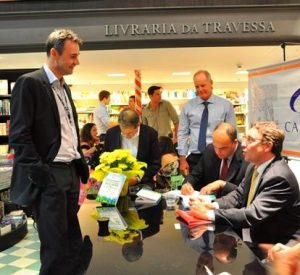

¿Comments? ¿Opinions? ¿Similar News? Send them to us!
Tweet
New Global Database on Bus Rapid Transit Launched
BRTdata.org provides most robust data to improve mobility and reduce carbon emissions from transit
Editor’s note: A webinar on the new brtdata.org database was held on Tuesday, April 10, at 12:00 p.m. EDT. Watch the recorded webinar here.
Washington (April 2, 2012) – Four global organizations have teamed up to launch the most comprehensive, public database of bus rapid transit (BRT) systems around the world. The new site, BRTdata.org, was created by the Across Latitudes and Cultures Bus Rapid Transit Centre of Excellence through EMBARQ, the World Resources Institute’s center for sustainable transport. The Database was created in collaboration with the International Energy Agency (IEA) and the Asociación Latinoamericana de Sistemas Integrados de Transporte y BRT (SIBRT).
BRT is one of the fastest growing public transport systems. Approximately 134 cities worldwide— from Bogota to Beijing— have implemented BRT systems or priority bus corridors, serving more than 22 million passenger trips daily.
BRT is a mode of public transport that flexibly combines stations, vehicles, services, running ways and intelligent transportation system elements into an integrated system.
“The new website provides reliable and up-to-date data to help researchers, transit agencies, city officials, and NGOs understand and make better decisions to improve BRT and bus corridors in their cities,” said Dario Hidalgo, member of ALC-BRT CoE and Director of Research and Practice, EMBARQ. “This is the first time that all of this publicly available data has been compiled in one place, but there is still more information available. We invite transit agencies and researchers to help us improve the knowledge base by sharing additional data to fill in the gaps.”
The new website allows users to compare BRT systems and bus corridors in all 134 cities in 36 countries. The database includes 95 different indicators on system operations, design and cost, including metrics like the number of passengers per day, commercial speed, and the length of corridors.
There is growing interest and demand for BRT as cities seek low-cost, sustainable urban transportation solutions. As the number of BRT systems increases, it is important to have current, accurate, and complete information about existing and planned systems.
The development of an online database was a joint data-sharing effort. EMBARQ and ALC-BRT CoE collected data mostly from Latin America, and the IEA contributed data from other regions.
“Previously, there was no single point of publicly accessible information about the worldwide BRT industry, and it was especially difficult to get an assessment of the industry’s size and how it was changing over time,” ALC-BRT CoE Director Juan Carlos Munoz said. “We finally have the right tools to set standards for this dynamic industry.”
Using information from this dataset, the IEA has estimated the energy and carbon dioxide (CO2) benefits of BRT implementation, and outlined several CO2-mitigation scenarios that rely in part on modal shift from light duty vehicles to public transit, including BRT. The IEA plans to recognize the extensive potential of BRT in its upcoming biennial report, “Energy Technology Perspectives 2012,” calling for the total network length of BRT systems to double by 2020.
“BRT is growing in importance as a transit alternative,» said Tali Trigg, energy analyst, IEA. «This database will be helpful to planners, and is an essential component in calculating energy efficient scenarios which inform decision makers of practical ways of transitioning to a more secure, sustainable and affordable energy future.”
Following are just a few examples of the data that is available from the new website:
- Worldwide, 129 new corridors have been implemented since 2000, and 37 since 2010.
- Latin American systems move more than 50 percent of global BRT daily passenger trips.
- 25 Brazilian cities have 87 bus corridors, totaling more than 560 kilometers– more than any other country.
- 18 of Asia’s 24 BRT systems began operations since 2006.
- Systems in 13 U.S. cities together carry nearly 600,000 passenger trips each day.
Watch a screencast tutorial on how to use new website.
¿Comments? ¿Opinions? ¿Similar News? Send them to us!
Tweet
Interview to Juan Carlos Muñoz and Darío Hidalgo (in Spanish)
This interview was held in the context of the CASPT12 conference held in Santiago on 23-27 July 2012. Juan Carlos Muñoz and Darío Hidalgo explained the relevance of the conference and the public transport systems of Santiago and Bogotá.
¿Comments? ¿Opinions? ¿Similar News? Send them to us!
Tweet
ITLS recognised for 21 years of achievement
Recently, The Institute of Transport and Logistics Studies (ITLS) of The University of Sydney, led by the Founding Director, and member of our CoE, Professor David Hensher, celebrated its 21st Anniversary. To learn more about ITLS and its 21 Years of Excellence, take a look at the video appearing below:
21 Years of Achievement – ITLS from THINKBOX on Vimeo.
Transport and supply chains are vital to the effective operation of our modern world. The Institute of Transport and Logistics Studies, located at the University of Sydney Business School, is dedicated to bringing about improvements within this important domain, by fostering innovation, and communicating best practice.
Internationally recognised as a leader in logistics studies, ITLS has forged partnerships around the globe, and regularly invites outstanding international scholars to teach and conduct research at The University of Sydney. ITLS also hosts a unique, regular global forum that provides an opportunity for academics and practitioners to come together and discuss contemporary transport issues.
Locally, ITLS is engaged with, and regularly drawn upon by the state Government, to provide research and advice for the provision of public transport services. Recent research on congestion charges and dedicated bus corridors have gained extensive media coverage.
The strong leadership and vision of Professor Hensher has much to do with the success of ITLS. In a relatively short time he has built a foundation which bodes well for ITLS achieving even great success in the future. Bravo and thank you to David and his colleagues!
Juan de Dios Ortúzar, also member of the CoE, was invited to the celebrations as a Keynote Presentation. His seminar title was: «Road pricing: An impeccable public policy – how can we sell it?». Here you can find David Hensher and Juan de Dios celebrating in Sydney:


¿Comments? ¿Opinions? ¿Similar News? Send them to us!
Tweet
Video: interview to Juan Carlos Muñoz regarding Metro de Santiago (in Spanish)
In this interview, our director Juan Carlos Muñoz, analizes the solutions Metro de Santiago is implementing to ensure a good service, considering its current peaks in demand.
The interview was recorded on June 15, 2012, by Canal 24 Horas TVN, in Spanish.
¿Comments? ¿Opinions? ¿Similar News? Send them to us!
Tweet
Interview to Luis Gutiérrez in Latin Infrastructure Quarterly
Source: 4th Issue of Latin Infrastructure Quarterly LIQ4 – page 36 (Jul-Sep 2012)
LIQ Talks to Luis Ricardo Gutiérrez, EMBARQ Latin America Strategic Director and General Secretary of the Latin American Association of Integrated Systems and BRT (“SIBRT”)
Could you briefly explain EMBARQ and SIBRT?
EMBARQ’s mission is to act as a catalyst and help implement environmentally and financially sustainable transport solutions to improve the quality of life in cities. Since 2002, the network has grown to include five Centers for Sustainable Transport, located in Mexico, Brazil, India, China, Turkey and the Andean Region, that work together with local transport authorities to reduce pollution, improve public health, and create safe, accessible and attractive urban public spaces. The network employs more than 100 experts in fields ranging from architecture to air quality management; geography to journalism; and sociology to civil and transport engineering. SIBRT brings together Latin America’s most influential Integrated Transit Systems and Bus Rapid Transit (“BRT”) agencies. SIBRT facilitates the exchange of knowledge, produces “best practice” studies of the management, standardization, and operation of urban public transport, and proactively promotes Integrated Systems and BRT adoption as the safest, most efficient and sustainable form of mass transit. The Association is committed to quality urban public transportation development. SIBRT is present in 19 cities of 8 countries, which together comprise more than 95 million urban inhabitants. Its Associates provide public transit services to more than 20 million riders per day on more than 700 km of exclusive bus corridors (further information in www.sibrtonline.org). SIBRT was created in April 2010 with headquarters in Curitiba. EMBARQ acts as SIBRT’s General Secretariat.
What is the functional concept of BRTs and why are they interesting for Latin America.
BRTs are high-performance transportation solutions for urban corridors with elevated demand. BRT was conceived as an alternative to metros and light rails, which are more expensive, take longer to implement, and are less flexible than BRTs. BRTs, like railways, are one solution to sustainable urban public transportation challenges; they are an important part in managing the complex transportation needs of growing cities.
Continue reading the rest of the interview here (pg 36).
¿Comments? ¿Opinions? ¿Similar News? Send them to us!
Tweet
Development Banks Announce "Game Changer" for Sustainable Transport at Rio+20
Source: EMBARQ
The world’s largest multi-lateral development banks — led by the Asian Development Bank, the World Bank, and others — committed to provide more than $175 billion over 10 years to support sustainable transport in developing countries.
The announcement was made at the UN Sustainable Development Conference in Rio de Janeiro (Rio+20) by the African Development Bank, Asian Development Bank, CAF- Development Bank of Latin America, European Bank for Reconstruction and Development, European Investment Bank, Inter-American Development Bank, Islamic Development Bank, and the World Bank.
Following is a statement from EMBARQ’s director, Holger Dalkmann:
«This is a game changer for sustainable transport. It will ensure that hundreds of millions of people will have cleaner air, less congested roads, and safer transportation.
Ten years ago transportation wasn’t even in the discussion; now it’s a major outcome from the world’s preeminent conference on sustainable development.
Banks are putting their money where it matters — on streets built for people, not just cars. The world’s population is expected to surpass 9 billion by 2050, with more than half living in Asia, mostly in urban areas. At the same time, the rate of vehicle ownership is predicted to skyrocket from around 800 million cars a decade ago to around 2 billion in 2030. These two mega-trends are coming together to create an environment where people must compete for financial, institutional, and physical resources. In response, we need better urban designs; more sustainable transportation modes, like walking, biking and mass transit; and improvements in existing vehicle and fuel technology.
This investment is not just about improving the way people move from point A to point B; it’s also about providing access and mobility for the poor and improving road safety, not to mention reducing transport-related greenhouse gas emissions. Transport is no small piece of the climate change pie: the sector represents approximately one-quarter of global CO2 emissions.
Today’s announcement will no doubt encourage other decision-makers, especially national governments, to consider financing transport projects based on social and environmental benefits. It will push sustainability into the core of urban development.
At the same time, we need to make sure that the money gets invested into the right kind of projects, and that there are sound mechanisms to measure its impact. This will require full transparency and independent monitoring.
Countries often invest in transportation and infrastructure, but much of that goes into highways. We need to be smarter about where money flows, whether that means creating vibrant public spaces, providing safer infrastructure for pedestrians and cyclists, or building high-tech, low-cost transit systems. Doing this would be a paradigm shift in the way we finance the growth of sustainable cities, similar to what the Asian Development Bank has done with its Sustainable Transport Initiative, a lending and technical assistance program for transport projects in Asia and the Pacific that emphasizes inclusive economic and environmentally sustainable growth.
EMBARQ, the World Resources Institute’s center for sustainable transport, is a founding member of the Partnership on Sustainable Low Carbon Transport, which helped to catalyze this new financial commitment by the banks.
Years from now, we may look back at Rio+20 as the moment when transport was pushed to the top of the sustainability agenda.”
¿Comments? ¿Opinions? ¿Similar News? Send them to us!
Tweet
Walk the line: station context, corridor type and bus rapid transit walk access in Jinan, China
This paper examines BRT station walk access patterns in rapidly urbanizing China and the relationship between bus rapid transit (BRT) station context and corridor type and the distance people will walk to access the system (i.e., catchment area). We hypothesize that certain contextual built environment features and station and right-of-way configurations will increase the walk-access catchment area; that is, that urban design influences users’ willingness to walk to BRT. We base our analysis on 1233 user surveys, conducted at 19 BRT stations along three existing (as of summer 2009) BRT corridors in the city of Jinan. Ordinary least squares regression is applied to estimate the relationship between walk access distances and aggregate station- and corridor-area characteristics, controlling for individual- and trip-specific attributes. The results suggest that people walk farther to BRT stations when the walking environment has certain features (median transit-way station location, shaded corridors, busy and interesting). Trip and trip maker characteristics play a relatively minor role in defining BRT walk access distance. Implications include the need for flexible transit station catchment area definitions in identifying transit-oriented development opportunities and estimating system demand.
Rio de Janeiro Opens Transoeste, the City’s First Bus Rapid Transit Line
Source: EMBARQ. This post was originally published in Portuguese on EMBARQBrasil.org.
Photo: Mariana Gil / EMBARQ Brazil. The new buses serving the Transoeste line, known as Ligeirões hold over 140 people
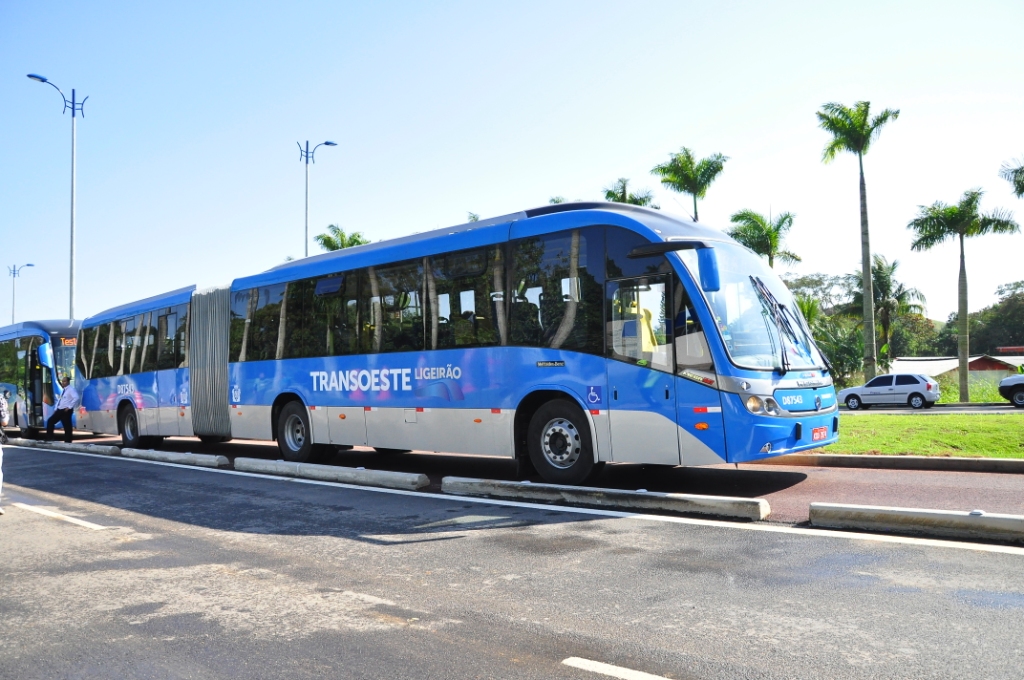
As world leaders gathered to address global sustainability at the Rio+20 Conference, the summit’s host city, Rio de Janeiro, just undertook its own green initiative— it launched its first bus rapid transit (BRT) corridor.
The lives of millions of cariocas, Rio de Janeiro residents, have already started to change with the opening of the Transoeste, the city’s first BRT corridor. The public transit system, developed with assistance from EMBARQ, expects to help hundreds of thousands of Rio residents, providing them with safer transport, shorter commutes, and less pollution.
“Today is a Great Day”
Mayor Eduardo Paes made the official announcement on June 6 at Pingo D’Água station in Guaratiba, West Zone, alongside former Brazilian president, Luis Inácio Lula da Silva, and Rio’s governor, Sergio Cabral. The director of EMBARQ Brazil, and member of our CoE, Luis Antonio Lindau, also took part in the event, strengthening the partnership between the organization and City Hall.
“Today is a great day,” said Lindau at the event. “Rio de Janeiro begins a new era of quality, efficiency and safety in Brazilian transit.”
EMBARQ Brazil, with support from Bloomberg Philantropies, has provided technical support to Rio’s City Hall through road safety audits, a crucial step to reduce the risk of traffic crashes on the corridor and to save lives. Partners also worked on several other actions to establish the first BRT in Rio.
The buses, nicknamed Ligeirões (meaning “super fast” in Portuguese) started to circulate on an experimental basis on June 6. During this first stage, which lasted until June 23, nine stations and 11 buses were operating off-peak, between 10:00 a.m. and 3:00 p.m. Other stations will gradually become operational.
Beginning in August 2013, when the system will become fully operational, the BRT will have an extension of 35 miles (56 kilometers) and 64 stations, with waiting times between buses of approximately one-and-a-half minutes. The system is estimated to benefit about 220,000 people each day, with most journeys being more comfortable and half as long as pre-BRT commute times.
Plans for the Future
Rio transporation officials plan on expanding the BRT system in the future, from one corridor to four. In total, 93 miles (150 kilometers) of BRT lanes will be built, changing mobility all over the Cidade Maravilhosa (Rio’s nickname, which means “wonderful city” in Portuguese).
«This is the first BRT, with others to come,” said Mayor Paes. “It is a cultural change around how people move about in the city. It’s like a subway train on wheels, at much lower costs.”
The four total corridors will include:
- Transoeste: An express bus corridor that will connect Barra da Tijuca to Santa Cruz and Campo Grande. The Transoeste will be 56 kilometers long and comprise 64 BRT stations. The average journey times are expected to be reduced by one-half on this lane. The first stage of the project is already operational on a trial basis and should be completed by August 2013.
- Transcarioca: The Transcarioca will be the first high-capacity corridor crossing the city transversally and connecting Barra da Tijuca to the international airport at Ilha do Governador on an exclusive, 24-mile (39 kilometer) lane. It is estimated that around 400,000 people will benefit daily from the system.
- Transolímpica: The 16-mile corridor (26 kilometers), connecting the neighborhoods of Deodoro and Barra da Tijuca via the Transolímpica, will be more than a way of shortening athletes’ journey times between the venues of the 2016 Olympic Games. Unlike the other three corridors under construction, this one will also be an expressway for cars, with no crossings or traffic lights, similar to Rio’s Linha Amarela.
- Transbrasil: This will be the fourth corridor to be built by Rio’s City Hall in time for the 2016 Olympic Games – 20 miles (32 kilometers) long and comprising 25 stations. This line will connect the Santos Dumont airport to Deodoro in the city’s West Zone, and will have the biggest demand of all, with 900,000 commuters per day. It will have connection points with the Transolímpica and the Transcarioca, as well as stations at Francisco Bicalho and Presidente Vargas avenues.
¿Comments? ¿Opinions? ¿Similar News? Send them to us!
Tweet
Event wrap up: 12 International Conference on Advanced Systems for Public Transport CASPT12
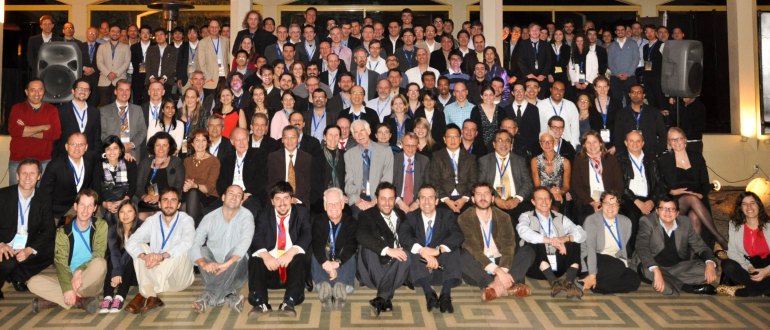
The twelfth version of the International Conference on Advanced Systems for Public Transport was held in Santiago, Chile from July 23 to July 27, 2012. This time the conference was organized by the Department of Transport Engineering and Logistics of the Pontificia Universidad Católica de Chile, with the support of the Bus Rapid Transit Centre of Excellence. This conference has become the most important in the field of design and operations of public transport systems. For the first time it was organized in the southern hemisphere and in a Latin American city.
For almost 40 years CASPT has served as a forum for the international community of researchers, practitioners and vendors involved on all aspects of public transport planning and operations (with similar emphasis in bus and rail based services). CASPT covers significant contributions to the theory and application of systems and methodologies for advancing public transport planning and operations. CASPT encourages not only the generation and presentation of new ideas, but also hopes to instigate productive collaborations between participants from academia, industry, and government.
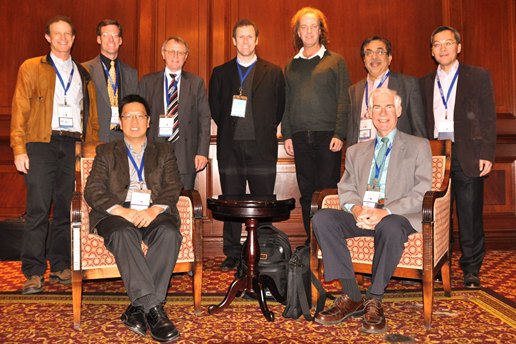 Traditionally, this conference attracts participants from many countries, most of them in North America or Europe. To increase its regional impact in South America, CASPT was organized in parallel to a meeting of the Latin American Association of Integrated Transit Systems and BRT (SIBRT) which guaranteed the participation of members of the most important transit agencies and operators of Latin America.
Traditionally, this conference attracts participants from many countries, most of them in North America or Europe. To increase its regional impact in South America, CASPT was organized in parallel to a meeting of the Latin American Association of Integrated Transit Systems and BRT (SIBRT) which guaranteed the participation of members of the most important transit agencies and operators of Latin America.
The call for extended abstracts received around 180 contributions. They came from over 30 countries from the 5 continents. By the end, 92 papers were presented, plus 7 plenary talks (3 by local authorities at the inauguration) and 15 talks at the SIBRT meetings. The following were the plenary talks:
- Urban Public Transport Policy in Chile – Pedro Pablo Errázuriz, Minister of Transports and Telecommunications of Chile
- Challenges of improving and expanding the Metro in Santiago, Chile – Roberto Bianchi, Chief Executive Officer Metro de Santiago
- Transantiago, a radical transformation: yesterday, today and tomorrow – Patricio Pérez, General Coordinator of Transantiago
- Urban Transport: A little less conversation, a little more action – David A. Hensher, Institute of Transport and Logistics Studies, The University of Sydney, Australia
- On Joint Rail and Property Development: Opportunities and Potential Pitfalls – Hong K. Lo, Hong Kong University of Science and Technology, China
- Traffic congestion in networks, and alleviating it with public transportation and pricing – Carlos Daganzo, University of California, Berkeley, USA
- Sustainable Transportation: Just a question of mode technology election? – Paulo Custodio, Private consultant, Brazil
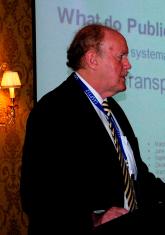

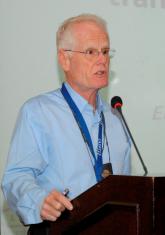
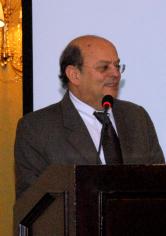
We had a bit over 250 attendants from 33 countries to the meeting (Australia, Brasil, Canada, Chile, China, Colombia, Denmark, Ecuador, Egypt, France, Germany, Hong Kong, Hungary, Iran, Ireland, Israel, Italy, Japan, Mexico, Netherlands, New Zealand, Peru, Portugal, Serbia, South Africa, Spain, Sweden, Switzerland, Taiwan, Turkey, UK, US and Uruguay) during the five days event, which included a Welcome Cocktail, a day trip to Casablanca Valley and Valparaíso, a Conference Dinner at the San Cristóbal hill and Technical visits in Santiago.
Additionally, the opportunity was taken for organizing a fair of software providers for managing, designing and control of public transport systems, as well as an open half-day Workshop between operators, academics, agencies and providers, where the firms had the opportunity to make a presentation about the products and services they offer. We had 7 firms presenting their products and services, and then a roundtable to discuss about them from a Latin American perspective. Around 60 people from firms, agencies, operators and academia attended it.
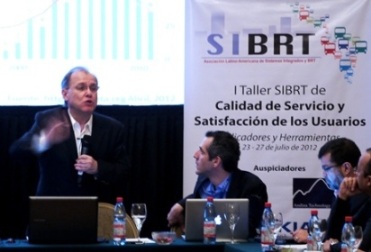
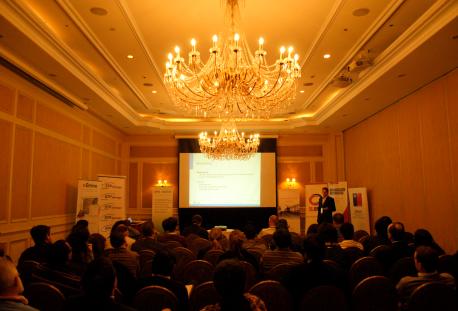
¿Comments? ¿Opinions? ¿Similar News? Send them to us!
Tweet
First SIBRT Service Quality and User Satisfaction Workshop
A Major Step in Latin America Towards High Quality Public Transportation for All
 The First SIBRT Service Quality and User Satisfaction Workshop, organized by SIBRT with the support of Transantiago, our ALC-BRT Centre of Excellence, and the EMBARQ Network, brought together more than 40 participants from 12 cities and six Latin-American countries to discuss how to offer high quality public transportation services and achieve user satisfaction. The event took place from July 23-27 in Santiago, Chile during the Conference on Advanced Systems for Public Transport, CASPT12.
The First SIBRT Service Quality and User Satisfaction Workshop, organized by SIBRT with the support of Transantiago, our ALC-BRT Centre of Excellence, and the EMBARQ Network, brought together more than 40 participants from 12 cities and six Latin-American countries to discuss how to offer high quality public transportation services and achieve user satisfaction. The event took place from July 23-27 in Santiago, Chile during the Conference on Advanced Systems for Public Transport, CASPT12.
The exchange of experiences is part of the growing and systematic benchmarking work underway by SIBRT, which was inspired by the precursory experiences of the Railway Technology Strategy Centre – RTSC of the Imperial College of London. This benchmarking work is being done in cooperation with our Centre of Excellence, which contributes scientific expertise to SIBRT. This cooperation was critical to ensure that the SIBRT Workshop in Santiago achieved world class quality.
“We need to recognize the contributions of visionary Professor Juan Carlos Muñoz, who leads the Center of Excellence, and the amazing work of his team of researcher from PUC Chile, and recognize the methodological guidance provided by Professor Luis Antonio Lindau, the President of EMBARQ Brazil, for opening a fruitful space for exchange and cooperation between the different actors that are responsible for providing quality public transportation services” asserted Luis Gutiérrez, Strategic Director for Latin America for the EMBARQ Network and General Secretary of SIBRT.
The discussions took place through SIBRT agency presentations and group dynamics covering each one of the three critical themes: managing user opinions, performance indicators and contractual mechanisms. The workshop permitted the agencies’ technical staff to learn about the point of view of the private operators from Colombia and Mexico and also from some transit suppliers, which added to the analysis that was being done in the small groups.
The work was led by André Jacobsen, SIBRT Benchmarking Expert, with the help of four professional facilitators that recorded all the ideas and suggestions expressed by the participants, so as to later synthesize all of the information and discussions from the workshop.
The closing session of CASPT12 served as another fruitful milestone for our work in Santiago. Public transportation supplies of planning, information, and management technology and software presented on their products to an audience of transit managers, operators, experts and consultants which led to a valuable and an acute discussion on the future of the industry and the services needed in the transit sector. SIBRT presented its vision on the modernization challenges facing public transportation providers in Latin America y the need to work together through strategic alliances. In this way, CASPT12 became a privileged setting for dialogue and cooperation between different transit sectors that had not come together in this format before. “We are very pleased with the work that occurred in this final meeting…Suppliers, managers, and operators were, for the first time, the protagonists of a process of exchanging experiences and concepts that were very constructive and creative, that we hope to see repeated in the future…Our Center will be ready to repeat this process as many times as is needed…”, said Juan Carlos Muñoz.
The knowledge gathered in the First SIBRT Service Quality and User Satisfaction Workshop will serve as the basis for the realization of a common strategic agenda. SIBRT, the Center of Excellence, and the EMBARQ Network have agreed to develop studies and guides of best practices that support all those involved in public transportation systems in Latin American cities so that they will have the opportunity to improve their capacity and implement services with the highest quality standards.
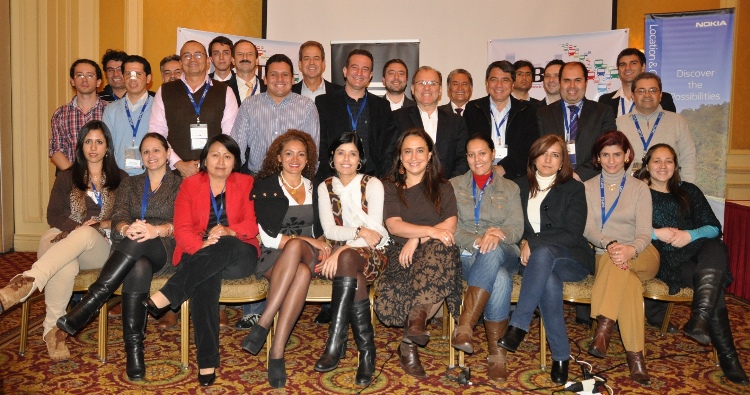
¿Comments? ¿Opinions? ¿Similar News? Send them to us!
Tweet
Traffic Safety on Bus Corridors: Pilot Version – Road Test
Source: EMBARQ
The purpose of this guidebook (launched a couple of months ago, as described here) is to provide bus agencies, local jurisdictions, as well as regional and international organizations with a set of suggested design, planning, and operational criteria that should be considered in the planning and design of new bus systems.
The information contained in these guidelines should by no means be used as standard details on which to base a final design, but rather as recommended criteria and general guidance which, in conjunction with engineering judgment and a thorough analysis of existing conditions on the corridors, should help develop final designs. Moreover, these are global guidelines representing general concepts and are not site or country specific, and they may not always be adapted to local design and signalization standards. The applicable local standards for signalization and markings should always be checked before applying the recommendations set forth in these guidelines.
EMBARQ will distribute the pilot version of the guidelines, available in English, Spanish, and Portuguese, to people involved in the planning and design of new bus corridors, including experts who work at multilateral development banks, government institutions, transit agencies, universities and transport consultancies.
To become involved in the “road test,” please contact EMBARQ Transportation Research Analyast Nicolae Duduta at nduduta@wri.org to receive a copy of the guidebook, as well as instructions on providing feedback.
Download full report:
English
Español
Português
¿Comments? ¿Opinions? ¿Similar News? Send them to us!
Tweet
The promise and challenges of integrating public transportation in Bogotá, Colombia
User perception of Bogotá’s integrated public transport system: trends and implications for program implementation
Several cities in the developing world are transforming decentralized bus transit services into integrated transit systems. These programs aspire to improve service quality and mitigate negative impacts, such as pollution and traffic injuries and deaths. However, implementation processes in Santiago, Chile and elsewhere have proven difficult. One contributing factor has been a lack of integration of community concerns in the planning process. In this paper, we provide a framework for direct identification of user needs and apply it to the ongoing process in Bogotá, Colombia. Bogotá is integrating its BRT system with reorganized bus services throughout the city. Using expert interviews and a semi-structured community survey, we identify awareness, expectations and aspiration gaps, as well as equity concerns. We also suggest specific actions to improve user information during system implementation. The methods developed for this research and understanding of Bogotá’s lessons are useful for improving planning and implementation of other large-scale transit integration processes.
Getting from A to B with less stress – David Hensher video
Source: What matters to you?
What matters to you? is a website developed by The University of Sydney, which publishes polls and compiles the opinions of the visitors who have chosen to participate in them.
One of the matters presented in June 2012 was «Getting from A to B with less stress», and a video with David Hensher was developed to address this matter. It is described as: David Hensher is developing ideas to improve public transport and reduce traffic congestion on our roads. In addition to the obvious environmental benefits, these changes will improve people’s lifestyles and productivity.
¿Comments? ¿Opinions? ¿Similar News? Send them to us!
Tweet
Express services for a bus corridor: A case study and some analytical insights
Embedding Risk Attitudes in a Scheduling Model: Application to the Study of Commuting Departure Time
In traditional travel time reliability valuation studies, the value of travel time savings and the value of travel time reliability (or reduced time variability) are estimated within a linear utility functional form, which assumes risk-neutral attitudes for decision makers. In this paper, we develop nonlinear scheduling models to address both risk attitude and preference in the context of a stated choice experiment of car commuters facing risky choices where the risk is associated with the trip time. We also investigate unobserved between-individual heterogeneity in time-related parameters and risk attitudes using a mixed multinomial logit model. The willingness-to-pay values for reducing the mean travel time and variability (earlier/later than the preferred arrival time) are also estimated within the nonlinear scheduling framework. The model is then used to estimate preferred departure times for commuters, assuming that random link capacities are the source of travel time variability. Results show that the more variable travel times are, the earlier commuters depart and that the nonlinear scheduling model predicts earlier optimal departure times than the linear scheduling model does. The application in this paper helps to bridge the gap between theory and practice.
Transporte Sustentável no Século Urbano
Access as a social good and as an economic good: is there a need of paradigm shift?
Funding and financing constraints in the aftermath of institutional design: a critical review
In the last years many countries started the reform of their legal and organizational frameworks for public transport, aiming to obtain better performances and improve the market shares of these services. Only a few cities succeeded in introducing effective change and overcome barriers to the reform process. Several background studies have exhaustively identified and assessed these barriers for different types of cities, but there is a deficit of analysis on the paths which were followed by those few cities which succeeded in the reform process.
In the background of this wave of reform is the evolution of urban areas that occurred in the last decades and changed patterns of mobility from a radial concentric shape towards a typical interaction spread across peri-urban areas and very often ignoring the city centre. This caused organized mobility services to extend beyond the administrative borders of the city and, consequently, the need to extend the scope of intervention of the mobility authority to all communities with a direct stake in the mobility system became more obvious, yet easier said than done.
The rationale behind this problem of extension of the scope of action and influence of the mobility system is relatively easy to understand but raises additional problems between that scope of action and the scope of intervention of the different institutions in charge of the several aspects of the system, such as territorial definition, financial autonomies, etc.
This paper aims to observe in a structured way the critical issues that surround this problem aiming to pursue in-depth research on institutional design and financing alternatives.
Evaluation of the traffic control system of open Bus Rapid Transit corridors: An application to the city of Guangzhou
Event Wrap Up: Transantiago and Metrobús – How to achieve social sustainability?

Profoundly reforming an urban transportation system is as complicated as trying to rebuild a house with the residents inside. Despite all the shortcomings accompanying the status quo of many urban transportation systems today, both the transportation operators and the users have adapted to the market conditions within which they operate, such that any change must proceed with caution. In other words, grand plans to improve public transportation in our cities must search for a balance between the technically desirable and the politically feasible. Putting all the emphasis on only one side (e.g., the technical) can derail reform, or weaken it to the point where the desired results are not realized. Although certainly not the only ones, two critical aspects to consider in the search for this balance are: the way in which reformers approach negotiations with existing operators; and the way in which they communicate with, and open up to the participation of civil society, more generally. Both aspects influence not only the feasibility of implementing reform but also the sustainability of the system once reformed.
In this context, our Centre of Excellence, together with the Institute of Sociology of the Pontificia Universidad Católica de Chile and MIT’s Department of Urban Studies and Planning convened a diverse group of academics, authorities, operators, and members of civil society to discuss and share lessons from the implementation of Transantiago, in the Chilean capital, and Metrobús, in the Mexican capital. The evento took place on Thursday, 31 May at the Pontificia Universidad Católica de Chile, in Santiago, and was inaugurated by the Chilean Minster of Transportation and Telecommunications, Pedro Pablo Errázuriz.
The design of the event aimed to focus on discussions rather than formal presentations. In the morning, authorities and operators from both cities spoke at a roundtable moderated by Professor Christopher Zegras, from MIT. Private sector participants included: Jesús Padilla, President of Corredor Insurgentes (the principal private operator of the Metrobús system), and Simón Dosque and Hector Moya (Managers of Transantiago’s Buses Vule y Subus Chile, respectively). Authorities included Jorge Rocha, Director of Planning and Evaluation of Metrobús, and Carolina Simonetti, from the General Coordination of Transantiago. Among the noteworthy conclusions from the discussion:
- Success apparently hinges upon moving from a scheme of confrontation (authorities versus entrepreneurs) towards one of collaboration and trust.
- The inclusion of existing operators in the BRT systems is, perhaps, necessary, but implies a complicated process (building consensus within the operators’ organizations themselves and the negotiation of contract terms) that undoubtedly increases project costs.
- These types of projects provide an opportunity to move from an association-based system (of gremios) towards a business-based system. This transition can be painful and generate losers, but it likely reduces negative externalities (accidents, congestion, pollution) and, perhaps, improves service levels for the user.
- The agreements generated with operators for the initial stages of the project should be flexible enough to be adjusted to the changing conditions during implementation.
- It is crucial to strengthen the parties involved (authorities and the private sector) that are committed to successful reform. Within both groups there are heterogeneous interests which the opposition can take advantage of to sabotage the process. In the case of authorities, it is important to avoid, as much as possible, an institutional design within which decision-making remains subdivided among multiple sub-units, as such a scheme fragments vision and responsibilities.
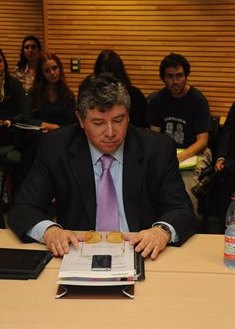


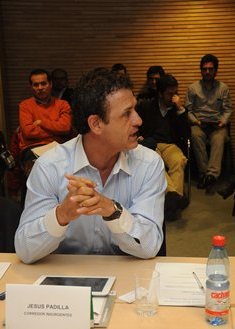
Photos: Andrés Salata
In the afternoon, Professor Manuel Tironi (Instituto de Sociología, PUC) moderated a dialogue titled “How to increase and improve citizen participation in the design and implementation of integrated BRT systems?” Marco Priego (EMBARQ, Mexico) and Sofia Lopez (Ciudad Viva, Santiago) participated as members of NGOs that have emphasized the need to modify certain aspects of the transportation systems in their respective cities. To provide the perspective of the authorities on these topics, the participants included Jorge Rocha on behalf of Metrobús and Germán Correa, ex-General Coordinator of the project that eventually became Transantiago. Among the conclusions from the roundtable:
- Citizen participation should be included, in a sustained manner, in all project stages.
- To speak of “citizen participation” in the abstract is not useful. We should specify the types of participation being considered and desired and clearly distinguish citizen participation (as an interactive political process) from simple marketing and information provision.
- There is a lack of specialists with experience in organizing citizen participation that can strengthen urban transportation system projects and improve prospects for success.
- Knowing citizens’ actual preferences is necessary to better approximate their behavior (e.g., in models); but such knowledge is insufficient for integrating citizens into the processes of design and implementation. We should also (a) better know their daily non-discursive activities and (b) enable them to participate more directly in decision-making.
- The success of citizen participation (and systems better-aligned with users) depends on recognizing the diversity of users and user profiles.
- We should take advantage of the possibilities for real-time interaction with users/citizens enabled by new communication technologies.
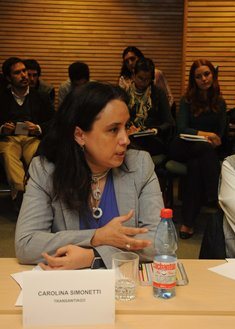


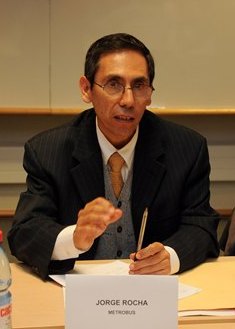
Fotos: Andrés Salata
This workshop was made possible thanks the support of the MIT International Science and Technology Initiatives (MISTI). The material discussed will be analyzed more deeply and serve to further strengthen the research of one of the research groups that participate in the Centre of Excellence ALC-BRT.
Download the full program of the Workshop (in Spanish).
Presentations (in Spanish) by:
Arturo Ardila-Gómez: Transporte y sustentabilidad política.
Christopher Zegras: Metrobús: BRT en Ciudad de México.
Manuel Tironi: Transantiago: Objetivos, Características y Desafíos.

Photo: Andrea Villena
¿Comments? ¿Opinions? ¿Similar News? Send them to us!
Tweet
Event Wrap Up: Transantiago and Metrobús – How to achieve social sustainability? (in Spanish)
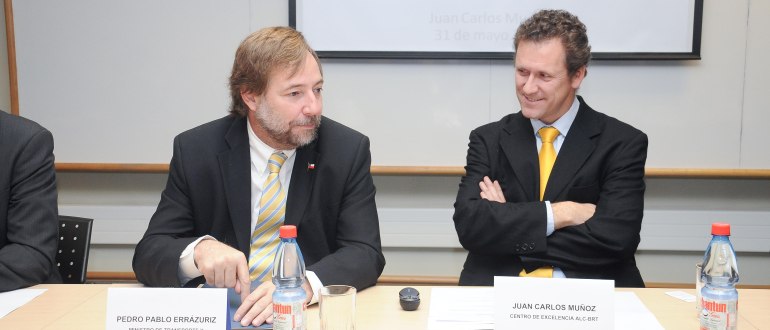
Reformar profundamente un sistema de transporte urbano es tan complicado como construir una casa con los habitantes dentro. A pesar de todas las fallas que puedan atribuirse al status quo, lo cierto es que tanto los operadores transportistas como los usuarios se adaptan a las condiciones del mercado en el que operan, por lo que cualquier modificación debe realizarse con sumo cuidado. En otras palabras, los grandes planes para mejorar el transporte urbano en nuestras ciudades deben buscar un equilibrio entre lo técnicamente deseable y lo políticamente posible. Cargar la balanza de un solo lado puede descarrilar la implementación de la reforma, o debilitarla de tal manera que no genere los resultados esperados. Aunque no son los únicos, hay dos temas críticos a considerar en la búsqueda de este equilibrio: La forma en que los implementadores abordan la negociación o incluso el conflicto con los operadores pre-existentes, y la manera en que comunican y abren el proyecto a la participación de la sociedad en general. Ambos temas inciden no solamente en la factibilidad de implementar la reforma, sino además en la sostenibilidad del sistema una vez que está en marcha.
Con esto en mente, el nuestro Centro de Excelencia, junto al Instituto de Sociología de la Pontificia Universidad Católica de Chile y el Department of Urban Studies and Planning de MIT, convocó a un grupo diverso de especialistas, funcionarios, empresarios y representantes de la sociedad civil para dialogar y compartir las lecciones resultantes de la implementación del Transantiago en la capital chilena, y del Metrobús en la Ciudad de México. El evento se realizó el pasado Jueves 31 de Mayo en las instalaciones de la Pontificia Universidad Católica de Chile, y fue inaugurado por el Ministro de Transportes y Telecomunicaciones de Chile, Pedro Pablo Errázuriz.
El diseño del evento pretendió privilegiar las conversaciones sobre las ponencias oficiales. Por la mañana tanto autoridades como operadores de ambos sistemas dialogaron en una mesa moderada el Profesor Christopher Zegras, de MIT. Participó Jesús Padilla, Presidente de Corredor Insurgentes (principal operador privado del Sistema Metrobús), así como Simón Dosque y Hector Moya (Gerentes de Buses Vule y Subus Chile, respectivamente). Por parte de las autoridades, nos acompañó el Director de Planeación y Evaluación del Metrobús, Jorge Rocha, así como Carolina Simonetti, de la Coordinación General de Transantiago. Entre las conclusiones que podemos destacar están las siguientes:
- Los sistemas más exitosos son los que logran transitar de un esquema de confrontación (autoridades vs empresarios) a un esquema de colaboración y confianza.
- La incorporación de transportistas tradicionales como operadores de BRT es quizás necesario, pero implica un proceso complicado (de construcción de consenso hacia el interior de las organizaciones y de negociación de los términos del contrato) que sin duda incrementa los costos del proyecto.
- Este tipo de proyectos ofrece una oportunidad para transitar de un sistema de organización basado en gremios a un sistema basado en empresas. Esta transición puede ser dolorosa para algunos actores y genera perdedores, pero promete menos externalidades negativas (accidentes, congestión, contaminación) y quizá un mejor servicio para el usuario.
- Los acuerdos generados con operadores para la etapa inicial del proyecto deben ser lo suficientemente flexibles como para ser adecuados a condiciones que pueden cambiar tras la implementación.
- Es vital fortalecer a las contrapartes (autoridades y empresarios) que están más comprometidos con el éxito de la reforma. En ambos grupos hay intereses heterogéneos y en ocasiones encontrados, lo que pueden aprovechar los opositores para sabotear el proceso. En el caso de las autoridades, es importante evitar en la medida de lo posible un diseño institucional en el que la toma de decisiones queda subdividida en múltiples sub-unidades, pues dicho esquema fragmentaliza la visión y el ámbito de responsabilidad de cada una.




Fotos: Andrés Salata
Por la tarde, el Profesor Manuel Tironi (Instituto de Sociología PUC) coordinó un diálogo titulado «Cómo hacer más y mejor participación ciudadana en el diseño e implementación de sistemas integrados y BRT?». Participaron Marco Priego (Embarq, Mexico) y Sofía Lopez (Ciudad Viva, Santiago), miembros de ONGs que han planteado la necesidad de modificar ciertos aspectos de los sistemas de transporte en sus respectivas ciudades. Para dar la visión de las autoridades sobre estos temas, estuvo nuevamente Jorge Rocha por parte de Metrobús y Germán Correa, ex-Coordinador General del proyecto que eventualmente se convirtió en Transantiago. Entre las conclusiones de la mesa destacan las siguientes:
- La participación ciudadana debe darse, de manera sostenida, en todas las etapas del proyecto.
- Hablar de «participación ciudadana» en abstracto no ayuda de mucho. Debemos concretizar de qué tipo de participación ciudadana estamos hablando y para qué la queremos, así como distinguir claramente entre participación ciudadana (como proceso político e interactivo) y simple marketing y entrega de información.
- Existe una carencia de especialistas que apoyen el desarrollo de modernizaciones de sistemas de transporte público, con una participación ciudadana que fortalezca y factibilice la implementación del proyecto.
- Conocer las preferencias declaradas es necesario para aproximarse más y mejor a la naturaleza de los usuarios, pero no es suficiente para integrarlos al proceso de diseño/implementación. Se debe también (a) conocer sus practicas cotidianas no-discursivas, y sobre todo (b) hacerlos partícipes directamente en toma de decisiones.
- El éxito de la participación ciudadana (y de sistemas sintonizados con los usuarios) depende de reconocer que existe una diversidad de usuarios/perfiles y no un usuario único.
- Debemos aprovechar las posibilidades de interaccion en tiempo real otorgadas por las nuevas tecnologías.




Fotos: Andrés Salata
Este seminario fue posible gracias al financiamiento del programa MIT International Science and Technology Initiatives, MISTI. El material discutido será analizado a mayor profundidad y servirá para nutrir a uno de los equipos de investigación que participan en el Centro de Excelencia ALC-BRT.
Baja el programa completo de la actividad.
Presentación de Arturo Ardila-Gómez: Transporte y sustentabilidad política.
Presentación de Christopher Zegras: Metrobús: BRT en Ciudad de México.
Presentación de Manuel Tironi: Transantiago: Objetivos, Características y Desafíos.

Foto: Andrea Villena
¿Comments? ¿Opinions? ¿Similar News? Send them to us!
Tweet
Bus Rapid Transit wanted in ACT
Source: Australasian Bus and Coach
A survey has shown more than 65 percent of Canberra residents want a rapid transit corridor between Gungahlin and Civic, according to government.
Environment and Sustainable Development Minister Simon Corbell says the survey, which sampled 1000 residents, shows about two thirds of the population want Bus Rapid Transit (BRT) or Light Rail Transit (LRT).
«While Light Rail Transit was chosen over Bus Rapid Transit by 68.5 percent of people surveyed before knowing the cost of each project, this figure fell to just under half (45.8 percent) with the preference for Bus Rapid Transit rising to about the same level (46.5 percent) once the likely costs were revealed,” Corbell says.
Corbell says the survey shows about 12.5 percent of respondents believe current public transport is acceptable.
Corbell says 32.3 percent of respondents cite environmental benefits as the main reason for prefering LRT, while 26.8 percent of people largely prefer BRT because of familiarity with bus transport.
Corbell says 14.9 percent of respondents believe BRT will be cheaper to build and maintain, 14.3 percent think it will be quicker to build and implement, and 10.3 percent believe it will be compatible with existing systems.
He says 9.7 percent also think buses could move around obstructions more easily, and 8.5 percent believe a BRT will be less intrusive.
«The survey also found that public transport improvements in the City to Gungahlin corridor were supported across the whole city – Inner South (60.6 percent), Woden-Weston (61.2 percent), Tuggeranong (61.9 percent), Inner North (65 percent), Gungahlin (70.0 percent), and Belconnen (70.3 percent),” Corbell says.
Corbell says more than 750 people attended information sessions about the project during the past three weekends at Dickson, Civic and Gungahlin and a further 560 people had completed an online survey.
Corbell says the survey was conducted by an independent consultant.
¿Comments? ¿Opinions? ¿Similar News? Send them to us!
Tweet
Video: Jaime Lerner talks about Public Transport in Latinamerica (in Spanish)
Source: SIBRT
El Presidente Honorario de SIBRT, Jaime Lerner, propuso en su mensaje seguir trabajando por la mejora sustancial de los sistemas de movilidad en buses en las ciudades latinoamericanas. Destacó la importancia de tener sistemas de alta calidad que responda a las necesidades de la gente para no depender del carro privado.
¿Comments? ¿Opinions? ¿Similar News? Send them to us!
Tweet
Event wrap up: XIX Conference of Urban and Suburban Transport in Mexico
Matías Fernández, member of our Centre of Excellence and researcher at the Institute of Sociology, Pontificia Universidad Católica de Chile, was invited to speak at the XIX Convención de Transporte Urbano y Suburbano (Conference of Urban and Suburban Transport), which took place at Puerto Vallarta, Mexico, on June 6, 7 and 8, 2012. In a Panel with representatives from Embarq-Mexico, Matías Fernández talked about «Political processes in the transition to BRT systems: the cases of Transantiago (Santiago, Chile) and Metrobús (Mexico City)». Between the audience there were transport leaders from all cities and states of Mexico, who nowadays are either participants or interested parties in several transport reforms in different cities of the country. For this reason, the presentation emphasized the weaknesses and strengths of the Transantiago experience: a system designed from a purely technical standpoint, excluding proper information, negotiation and participation processes –with dramatic consequences– but achieving a fully integrated transport system for the entire city of Santiago in a very short period of time.
Arisen from the contrasts between Metrobús and Transantiago experiences, the researcher proposed to seriously discuss the following questions: Is it possible to reconcile graduality with integrity in public transportation systems’ reforms? Which are the costs and benefits of the lack of participation and information processes in Mexico and Chile? Which consequences have had the negotiation processes in both cities?
The numerous differences between Metrobús and Transantiago, the researcher hypothesizes, would come from different ways of doing politics in both countries, and he draw attention to agents involved in design and implementation of BRT systems to properly consider the political dimension as a constitutive aspect of the possibilities and limitations of reforms to public transport systems in Latin American cities.
Download the full conference program (in Spanish).
¿Comments? ¿Opinions? ¿Similar News? Send them to us!
Tweet
Press Release by EMBARQ: New Traffic Safety Guidelines Can Save Lives on Bus Corridors Worldwide
Source: EMBARQ
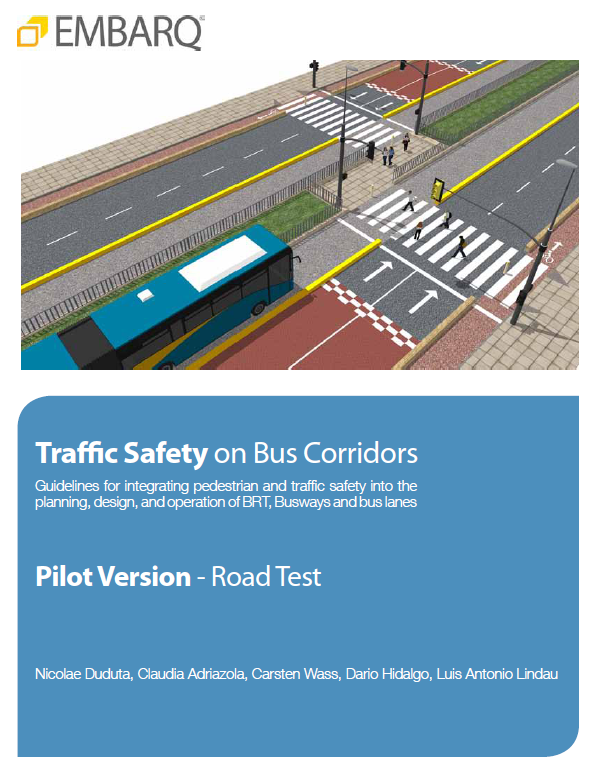
WASHINGTON (May 30, 2012) – Each year, 1.2 million people die in traffic crashes, according to the World Health Organization, and traffic fatalities are projected to become the fifth leading cause of premature death worldwide by 2030, ahead of HIV/AIDS, violence, tuberculosis, or any type of cancer. One way to prevent many of these deaths and injuries is to improve traffic safety, especially on major bus corridors in cities. EMBARQ, the World Resources Institute’s center for sustainable transport, today released the draft “Traffic Safety on Bus Corridors” guidelines to improve traffic safety on bus corridors worldwide. Based on more than two years of research, the guidelines are part of the Road Safety in 10 Countries (RS10) project, funded by Bloomberg Philanthropies.
“This guidebook is part of a broader effort by EMBARQ to illustrate how sustainable transport projects can greatly improve traffic safety, and ultimately, save lives and improve quality of life for people around the world,” said Holger Dalkmann, director of EMBARQ.
The guidelines are based on findings from a two-year research project, led by EMBARQ, which evaluated safety, operations and accessibility on major bus corridors and bus rapid transit (BRT) systems in 18 cities around the world. Key findings show:
- Pedestrians account for the majority of fatalities across all bus corridors;
- Safety on BRT and bus corridors depends on the overall design of the street and not just the bus infrastructure;
- Center-lane BRT corridors with closed stations are the safest design option;
- Counterflow, when buses drive in the opposite direction of mixed traffic, is the most dangerous type of configuration for a bus corridor; and
- The most common types of vehicle collisions in BRT systems occur when cars make illegal left turns across bus lanes and collide with oncoming buses.
“BRT and bus routes are often located on major urban roads, which have the highest concentration of traffic crashes in cities,” said Claudia Adriazola, director of EMBARQ’s Health and Road Safety program. “A new BRT system can attract a lot of pedestrians to these areas, so it is crucial to help cities understand how to maximize safety for everyone on the road.”
The purpose of the draft planning and design guidelines is to provide bus agencies, local jurisdictions, and regional and international organizations with a set of suggested design, planning, and operational criteria for bus systems, including BRT corridors. The guidelines include recommendations for street design, intersections, stations, and station access, as well as transfers and terminals.
“Data has shown that after the implementation of some BRT systems, such as TransMilenio in Bogota or Macrobus in Guadalajara, crashes and fatalities on these corridors dropped by as much as 50 percent,” said Dario Hidalgo, director of EMBARQ’s Research and Practice, member of our Centre of Excellence and an author of the guidelines. “Not all bus systems have had a positive impact on safety, and in some cases, there is still considerable room for improvement, which is why EMBARQ developed these guidelines to improve traffic safety.”
The research included iconic BRT systems in places like Curitiba and Bogota, Colombia, megacities Mexico City and Rio de Janeiro, as well as examples from New Delhi and Ahmedabad, India, and Brisbane, Australia.
“Our research shows that the design of a bus corridor can have a significant influence on the frequency of crashes on the street,” said Luis Antonio Lindau, president of EMBARQ Brazil and member of our Centre of Excellence, who contributed to the research.
During the next six months, experts are invited to provide feedback on the content, methodology, feasibility, and usefulness of the safety recommendations. The feedback will be incorporated into the final version of the guidelines, to be released in 2013.
To participate in the “road test,” please contact EMBARQ Transportation Research Analyst Nicolae Duduta at nduduta@wri.org.
Download full report:
English
Español
Português
¿Comments? ¿Opinions? ¿Similar News? Send them to us!
Tweet
Video: interview to our Director, Juan Carlos Muñoz (in Spanish)
Check out the video, where Juan Carlos Muñoz analyzes the following situations currently happening in Santiago:
- Metro de Santiago demand during peak hours
- Changes in Transantiago’s operators contracts
- Costanera Center opening
¿Comments? ¿Opinions? ¿Similar News? Send them to us!
Tweet
Opinion Pieces: The number of people using train services in the peak suggests that BRT should (must) have a real future
Opinion Pieces: since 2007, Prof. David Hensher has written an opinion column in the Australasian Bus and Coach magazine, where he monthly discusses a lot of different transport-related hot topics. In this section we are revisiting these columns.
August 2011
One of the main arguments used to support rail investment over bus systems is the carrying capacity of trains per hour. We are told that bus rapid transit (BRT) could never provide the service capacity required to offer an alternative to heavy rail investment. What is the evidence? We look at the recent figures provided by CityRail in Sydney.
The one hour morning peak to the city as measured at various stations for the nine metropolitan lines (excluding the Blue Mountains and the Central Coast) shows a maximum of 17,280 passengers on the Western line passing through Redfern Station (a station next to Central). The next highest patronage is 16,905 on the Illawarra line at Sydenham, followed by 16,680 on the North Shore line passing through St Leonards Station. The patronage drops off very fast, down to 11,735 per morning peak hour on the Airport and East Hill lines, with the remaining lines having patronage levels at surveyed locations between 9,615 and 3,810. The best in the afternoon peak from the city is 15,240 passengers counted at Redfern on the Western line.
With this factual evidence, let us note that many of the BRT systems (including Brisbane busway system) already have up to 10,000 passengers per hour (see graph below), which covers peak patronage levels for all but four of the nine lines in Sydney, with growing evidence that BRT can accommodate all patronage levels currently observed on the entire CityRail network.
Food for thought
¿Comments? ¿Opinions? ¿Similar News? Send them to us!







